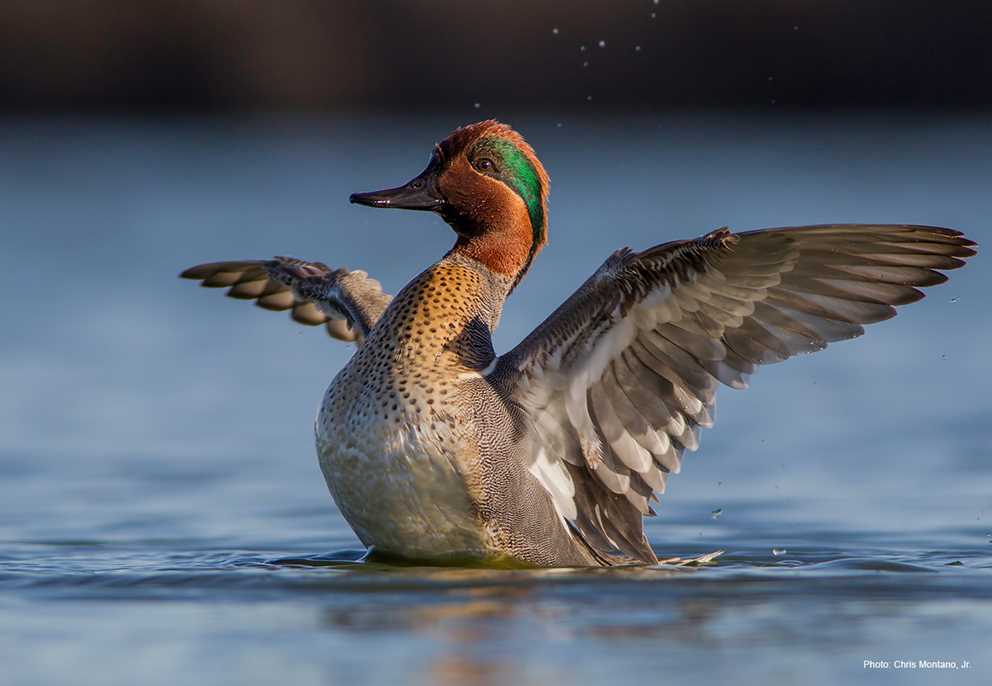Overview
The Green-winged Teal is a small dabbling duck with a circumpolar distribution across North America (A. crecca carolinensis) and Eurasia (Anas crecca crecca). It is the smallest dabbling duck in North America, where its breeding range extends from Alaska across most of boreal and prairie Canada to Newfoundland and Labrador. Its winter range includes coastal British Columbia most of the western and southeastern United States and Mexico.
Green-winged Teal males in alternate plumage are unmistakable, with a cinnamon head with an iridescent green stripe anterior to the eye to the back of the slightly crested head. The breast is buff tan, with black spots.he back and flanks are gray and black, and the belly is white. There is a black-bordered cream-yellow triangle on each side of the rump/vent. The bill is dark gray, and the feet are gray. In flight, the gray wing shows an iridescent black-green speculum with a rusty-orange anterior border on the secondary coverts. Females and males in basic plumage are mottled brown with dark gray bills and gray feet. The female wing is brown with an iridescent black-green speculum with a white anterior border.
Description
Key Identification Features:
- Green-winged Teal males in alternate plumage have a cinnamon head with an iridescent green stripe anterior to the eye to the back of the slightly crested head. The breast is buff tan with small black spots. The back and flanks have gray and black vermiculation. The belly is white. There is a black-bordered cream-yellow triangle on each side of the rump/vent. The bill is dark gray, and the feet are gray.
- Females and males in basic plumage are mottled brown with dark gray bills and gray feet. The female wing is brown with an iridescent black-green speculum with a white anterior border.
Male/Female Average Length and Weight
- Mass: Males 0.7 lbs.; Females 0.6–0.7 lbs.
- Wing Length: Males 7.3 in.; Females 7.0 in.
Male Identification:
- Alternate (Breeding) Plumage: Green-winged Teal males in alternate plumage are unmistakable, with a cinnamon head with an iridescent green stripe anterior to the eye to the back of the slightly crested head. The breast is buff tan with small black spots. The back and flanks are vermiculated gray and black. The belly is white. There is a black-bordered cream-yellow triangle on each side of the rump/vent. The bill is dark gray, and the feet are gray.
- Basic Plumage: Females and males in basic plumage are mottled brown. The head is light brown, and the bill is bluish gray. Males in basic plumage can be separated from females by characteristics of the secondary coverts and speculum, with males having a brighter iridescent black-green speculum, with a rusty-orange anterior edge, and females having a white anterior edge and less colorful speculum.
Female Identification:
- Alternate (Breeding) Plumage: Females are mottled brown with dark gray bills and gray feet. The wing is mottled brown with an iridescent black-green speculum with an anterior white edge.
In-Flight Identification:
- In flight, the gray wing shows an iridescent black-green speculum with a rusty-orange anterior border on the secondary coverts on males, and a white anterior border on females.
Vocalizations:
- Males: Give a distinct two syllable whistle described as “prip-prip.”
- Females: Give a soft decrescendo “quack” often in 4–7 repetitions.
Similar Species:
-
For the most part the species is unmistakable in North America. Small size and lack of blue wing patch separates from both Cinnamon and Blue-winged Teal, especially notable in flight.
Habitat Preferences
- Breeding: Prefers freshwater wetlands, lakes, rivers, and pools with fringe emergent vegetation.
- Winter and Migration: Prefers freshwater wetlands, brackish coastal wetlands, rice fields are favored. During migration, they may forage in waste grain fields though this is not common.
Foraging Habits and Diet
- Green-winged Teal prefer seeds and grains. Their diet is typically 80 to 90 percent seeds, with greater than 10 percent invertebrates. Percentage of invertebrates is likely much higher for nesting females.
Breeding Habits
- Monogamy: Green-winged Teal are seasonally monogamous. Pair formation is usually in winter, with bonds maintained through winter into the incubation period.
- Nest Location: Green-winged Teal nest in grasslands usually within 700 feet of water, with the nest well concealed under vegetation.
- Clutch Size: 6 to 9 eggs. The eggs are white to pale olive buff, elliptical to sub-elliptical, and are 1.8 by 1.3 in. The incubation period is 20 to 23 days.
Migration & Distribution
- Fall Migration: Green-winged Teal in North America are mid-fall migrants, departing breeding areas from September to October. They arrive in wintering areas as early as early September, and most are in wintering areas in October and November.
- Spring Migration: They also are mid-spring migrants departing winter areas in February with arrival on breeding areas in the Prairie Pothole Region in late April to early May, and in boreal areas in early May.
Conservation Status
- IUCN Status: Least Concern
- Population Status: Based on the USFWS Waterfowl Population Status, 2024 the breeding population was about 2.5 million with a long-term average of 2.1 million.
- Conservation Concerns: Deterioration of wetland habitats can potentially impact populations.
- Conservation Focus: Maintenance of habitat in the breeding and wintering range.
Harvest Information
- An average of 1,351,121 Green-winged Teal were harvested annually across the US from 2019 to 2022.
- Green-winged Teal harvest is highest in the Mississippi Flyway, accounting for 30 to 40 percent of the total US harvest.
- The top three harvest states during the 2019 to 2022 hunting seasons were California (1,056,784), Texas (659,907), and Arkansas (557,666









